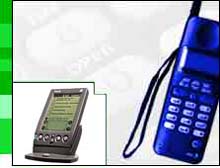|
|
| CNN WEB SITES: |

|
| TIME INC. SITES: |
| MORE SERVICES: |
| video on demand |
| video archive |
| audio on demand |
| news email services |
| free email accounts |
| desktop headlines |
| pointcast |
| pagenet |
| DISCUSSION: |
| message boards |
| chat |
| feedback |
| SITE GUIDES: |
| help |
| contents |
| search |
| FASTER ACCESS: |
| europe |
| japan |
| WEB SERVICES: |
Nokia, Palm join forces on handhelds
|
October 15, 1999 by Rob Garretson |
From... |

GENEVA (IDG) -- 3Com's Palm Computing and Nokia will jointly develop products that wed the pen interface of handheld Palm computers with wireless phones, the companies announced.
Under the agreement announced here at Telecom 99, Nokia will license the Palm OS and develop pen-based wireless devices that can run Palm applications, Anssi Vanjoki, senior vice president for Europe and Africa at Nokia Mobile Phones, said at a press conference. The first Nokia pen-based phones will hit the United States in 2001, followed by a worldwide rollout, he said.
| MESSAGE BOARD | ||
| ||
The two companies will jointly develop an implementation of the Palm OS running on top of the EPOC 32 kernel from Symbian and used in Nokia's "smart phones."
In addition to new pen-based products from Nokia, the joint development will produce new wireless communications capabilities for future Palm branded and licensed products, including implementations of WAP (Wireless Application Protocol) and Bluetooth technology for wireless local area networking, said Alan Kessler, president of Palm Computing.
The alliance with Nokia is the latest in a series of recent endorsements of WAP by Palm Computing and brings together seemingly competitive schemes for delivering Web content to wireless devices. The jointly developed technology will incorporate Palm Computing's "Web clipping" system as well as WAP, both designed to allow Web content specially prepared for handheld devices to be delivered over wireless connections to the Internet.
|
| ||
|---|---|---|
|
|
IDG.net home page | |
| InfoWorld home page | ||
| InfoWorld forums home page | ||
| InfoWorld Internet commerce section | ||
| Get Media Grok and The Industry Standard Intelligencer delivered for free | ||
| Reviews & in-depth info at IDG.net | ||
| IDG.net's personal news page | ||
| Year 2000 World | ||
| 3Com's Palm, Symbian set to cooperate | ||
| Palm VII highlights trio of new devices | ||
| Where is WinCE going? | ||
| Questions about computers? Let IDG.net's editors help you | ||
| Subscribe to IDG.net's free daily newsletter for IT leaders | ||
|
Search IDG.net in 12 languages | ||
| News Radio | ||
|
|
Fusion audio primers | |
|
|
Computerworld Minute | |
The combination of the Palm OS with the EPOC operating system from the leading suppliers of handheld computers and mobile phones, respectively, is competitive with Windows CE, which Microsoft Chairman Bill Gates demonstrated running on a mobile phone. Yet in response to a question, Vanjoki declined to characterize Nokia's alliance with Palm Computing as an "attack" on Microsoft.
"We don't 'attack' anybody. We are only for ourselves," Vanjoki said.
Nokia chose the Palm OS over Windows CE because of its market dominance, the breadth of applications available for the system and its relatively satisfied installed base of users, Vanjoki said.
"There are millions of happy [Palm OS] users out there," he observed.
Separately, Palm Computing announced that it would cooperate with Symbian and potentially cross license technology, but did not disclose any specific joint development plans. But at the press conference with Nokia, Kessler said Palm has little need to license EPOC directly from Symbian, and that it will license the software developed with Nokia to other Symbian partners. The announcement with Symbian was made, in part, to underscore that Nokia's commitment to Symbian is no way threatened by its alliance with Palm, Kessler explained.
Symbian is a joint venture of Nokia, Ericsson, Psion, Motorola and Matsushita Electrical. It was founded to promote Psion's EPOC operating system for wireless information devices.
Rob Garretson is editor in chief of the IDG News Service.
RELATED STORIES:
Father of cell phone eyes revolution
October 14, 1999
Gates demos WinCE smart phone
October 13, 1999
Motorola products show wireless focus
October 13, 1999
Electrolux, Ericsson join to connect homes
October 11, 1999
Internet World: Handspring grabs the spotlight
October 8, 1999
New WAP phones offer Net access
September 23, 1999
Son of Palm - cheaper, faster, expandable
September 13, 1999
RELATED IDG.net STORIES:
Gates shows off WinCE smart phone
(InfoWorld Electric)
3Com's Palm, Symbian set to cooperate
(InfoWorld Electric)
Competition should serve to spur on Palm
(InfoWorld Electric)
Palm rip-offs pale by comparison
(InfoWorld Electric)
Where is WinCE going?
(InfoWorld Electric)
Handspring and its add-ons steal the show
(InfoWorld Electric)
Palm VII highlights trio of new devices
(InfoWorld Electric)
3Com to split in two; Palm Computing to go public
(InfoWorld Electric)
Note: Pages will open in a new browser windowExternal sites are not endorsed by CNN Interactive.
RELATED SITES:
3Com's Palm Computing
Nokia Corp.
Symbian PLC
Note: Pages will open in a new browser windowExternal sites are not endorsed by CNN Interactive.
| LATEST HEADLINES: |